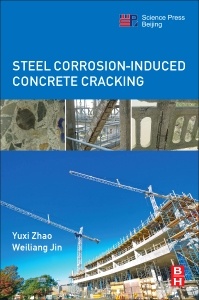Description
Steel Corrosion-Induced Concrete Cracking
Authors: Zhao Yuxi, Jin Weiliang
Language: English
Subjects for Steel Corrosion-Induced Concrete Cracking:
Keywords
Empirical model; Analytical model; Concrete cracking; Steel corrosion; Review; Electrochemical process; Carbonation; Chloride ingress; Iron oxides; Expansion coefficient; Modulus; Modelling studies; Parametric studies; SEM; Interface; Millscale; Crack; Interface; Corrosion layer; Non-uniform; Gaussian function; Recycled aggregate; Rust free expansion; expansive pressure; rust filling; X-ray diffraction; thermal analysis; expansion coefficient; elastic modulus; cyclic low-compression test; non-cracking; partial cracking; damage analysis; radial loss; steel bar; rust layer thickness; rust distribution; Gaussian model; non-uniform distribution; crack shape; crack width model; corrosion-filled paste(CP)
100.44 €
In Print (Delivery period: 14 days).
Add to cartSupport: Print on demand
Description
/li>Contents
/li>Readership
/li>Biography
/li>Comment
/li>
Steel Corrosion Induced Concrete Cracking presents the latest advances in the origin, mechanism and development of corrosion-induced cracking in concrete. It investigates topics including expansion coefficient and elastic modulus of steel corrosion, rust layer and rust distribution, spatial distribution of corrosion products, the shape of corrosion-induced cracks and so on.
This book concludes by proposing an improved corrosion-induced cracking model, which considers the phenomena of the simultaneous occurrence of corrosion layer accumulation and corrosion filling in concrete.
This book will be a valuable reference book for researchers and graduate students in the field of concrete durability and concrete structure, and industry engineers who are concerned with the deterioration mechanisms and the life cycle of reinforced concrete structures.
Fellow of the Institute of Civil Engineers (ICE) and an honorary professor in Queen's University, UK. His research interest includes structural reliability, durability of reinforced concrete structure, health monitoring of concrete structures, and fundamental theories of concrete structures and their applications. He founded the group on Durability of Concrete Structures in 1995 at Zhejiang University, which carries out research on the durability problems regarding environments, materials, concrete components and structures. He has been awarded 20 research grants by the Chinese government and has published more than 200 articles, co-authored 9 monographs. He also won 3 National Awards for Science and Technology Progress and 5 Science & Technology Awards of Zhejiang Province. Prof. Jin previously held research fellowships from the Alexander von Humboldt Foundation and the Norwegian Council of Research.
- Proposes a new corrosion-induced concrete cracking model, which takes into account the phenomenon of the simultaneous occurrence of corrosion layer accumulation and corrosion filling paste.
- Investigates the parameters and values of expansion coefficients and elastic modulus of steel corrosion, which enables a more rational prediction of concrete surface cracking
- Introduces the use of the Gaussian function to describe the non-uniform spatial distribution of corrosion products.




